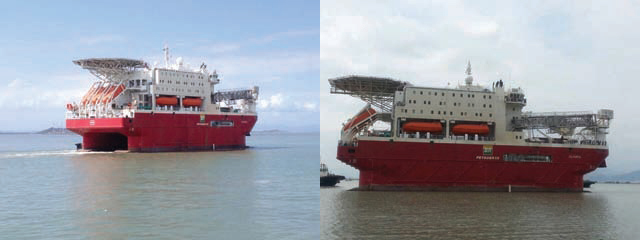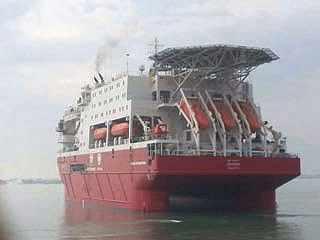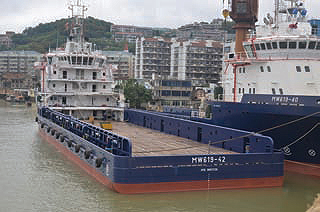
MAC Offshore: Leading with Innovative Maritime Solutions
Ripe for economical success
Since it was founded in 2009, Marine Assets Corporation (MAC) has operated as a pioneering supplier of modern and sophisticated vessels to the offshore oil and gas industry as well as a founding developer of the compact semi sub (CSS) concept.
The roots of the company however can be traced back several years earlier when its forbearer was established by founders with a pedigree within the oil and gas market, as MAC CEO Robin Reeves elaborates: “The company started life as Minnow Marine Projects (MMPL) back in 2006, formed by myself and several former management colleagues from a time that we had worked in Qatar  with Doha Marine Services. The company was formed as a Dubai Maritime City free zone entity and had 12 platform supply vessels (PSV) under construction, and by 2008 two of these were sold to a Singapore based interest. Then the balance of the remaining ten vessels under construction was sold with the company to Stanford Marine Group in Dubai in 2009.”
with Doha Marine Services. The company was formed as a Dubai Maritime City free zone entity and had 12 platform supply vessels (PSV) under construction, and by 2008 two of these were sold to a Singapore based interest. Then the balance of the remaining ten vessels under construction was sold with the company to Stanford Marine Group in Dubai in 2009.”
As the purchase of MMPL by Stanford Marine Group was enacted in 2010, MAC went into operation to hold a share interest in the CSS concept and has since continued to develop, promote and deliver the technology to the oil and gas market. The ten-year process of designing and finally building the first CSS involved several years of raising capital, design and conceptual engineering before the build process could begin. The yard chosen to build the first CSS was Fujian Mawei Corporation in China, which had previously constructed PSVs for MMPL, giving it a proven reputation and long standing relationship with the MAC management team. The build process itself took three years to complete because of the remarkable interest shown in the project by potential charterers and owners, many of which offered technical opinions that would be incorporated into the vessel while construction was ongoing. In this sense it can be said that the CSS concept is truly a targeted market solution with years of innovation and client input factored into its construction and as such, the vessel would eventually find an owner and begin a successful career in operation.
“The vessel was eventually sold to a Brazilian interest in mid 2013 and she was finally delivered in January 2014,” Robin says. “She is operating a long-term contract with Petrobras and performing very well and the buyer of the unit has been highly impressed by it, noting that it was designed as a cost effective solution to the offshore accommodation market. Semi sub technology has strong sea keeping capabilities, so by making the CSS compact in size and compact to build it is a cost effective solution. Following this the new owner has signed an order for another two vessels, so that the first three of our CSS vessels are being delivered to the same owner in Brazil.”
The CSS concept continues to spread to new clients around the world, having impressed operators in Brunei and leading to the order of a vessel that will be deployed on a contract with Brunei Shell. “This is a slightly different design,” Robin explains. “The basic hull design is the same but because of the benign waters in South East Asia the vessel does not need as much power and hence reduced powered thrusters. The client needed more deck space and less accommodation. This demonstrates a huge advantage in our design in its ease of adaption depending on customer requirements.”
The basic design of the CSS can be adapted to offer accommodation for between 200 to 500 personnel and incorporate deck space of between 500m2 and 1500m2. Furthermore the design can be fitted with cranes with capacities ranging from 50 tonnes to 150 tonnes and telescopic walkways at lengths ranging from 19 metres through to 42 metres.
Although MAC is keen to market the benefits of its CSS concept, the company retains the expertise from its early roots and continues to deliver PSVs to the oil and gas market. These range in size from 60 metres at 1500DWT, 75 metres at 3500DWT through to 87 metres at 5000DWT, covering a full range of diesel electric propulsion. The vessels feature modern design and the latest technology with equipment such as thrusters and dynamic position systems that are typically provided by Western European suppliers.
Having successfully brought its CSS concept to market, MAC is busy developing new vessel types in anticipation of the future needs of the oil and gas market. With a wealth of experience  incorporated into the company from its inception, MAC is well place to understand the needs of its clients and the fluid market in which they operate. “Going forward we have some new projects in the pipeline. For example, we are again developing a speculative vessel that we call MAC Motel. It is basically a compromise between a large CSS accommodation vessel with a little more capability than a conventional workboat. It will have 240 beds, a hull based on mono-hull design, a crane and helideck as well as a gangway to support offshore walk to work construction and maintenance activities. This is something that could well be interesting to the European wind farm industry,” Robin says.
incorporated into the company from its inception, MAC is well place to understand the needs of its clients and the fluid market in which they operate. “Going forward we have some new projects in the pipeline. For example, we are again developing a speculative vessel that we call MAC Motel. It is basically a compromise between a large CSS accommodation vessel with a little more capability than a conventional workboat. It will have 240 beds, a hull based on mono-hull design, a crane and helideck as well as a gangway to support offshore walk to work construction and maintenance activities. This is something that could well be interesting to the European wind farm industry,” Robin says.
“Our business plan is to try to identify the vessels that will be required by the oil and gas market and offshore wind industry over the coming years. We try to be ahead of the game and speculatively build vessels when we see the opportunity arising. We’ve been very fortunate in the past with timing that correctly, and with a good ‘crystal ball’ hopefully we will continue to be,” he says.
With a proven track record of innovative design and successful delivery to market, MAC has good reason to be confident. Its unique designs are tailored to the evolving needs of the market and provide the company with a niche portfolio that competitors would find difficult to replicate. As MAC continues to promote its innovative designs, its vessels are sure to become an increasingly familiar sight throughout the world over the coming years.
Marine Assets Corporation
Services: Offshore support vessels